Poking it’s nose out of the garage we find a Jaguar that has already made at least two trips across the Atlantic Ocean! Thanks to our own Jeff L. for this great find, which is located in Pennyland, Buckinghamshire, United Kingdom and is offered here on eBayUK with a buy it now of 6,500 pounds ($8,672 as I write) but lower offers are welcome.
The seller tells us that the car has recently been re-imported from Southern California after having been there for 30 years. The seller tells us that it does have rust issues in the floor pans and at the rear of the sills under the spats, but that neither are as bad as typical British Mk. 2 finds. I think this will take some fairly tedious work to get the body back up to snuff, but considering what these bring in the UK, it will probably be worth it.
The nose reminds me of my father’s 1966 S-Type; the leaping cat mascot is truly a thing of beauty up close! The car seems to be relatively complete, with only the keys, two gauges and the window surrounds missing. The seller reports some of the chrome is good, but other pieces will need to be plated or replaced.
Let’s just say the inside is pretty darn rough and leave it at that. There’s some wood missing too, I think, unless it’s in the car somewhere. I wish the seller had taken some better shots in here so you really had an idea if any of it could be saved. I’m not counting on it, though!
I’ve heard some arguments that the 3.4 liter XK engine was actually a better engine to run than the larger 3.8 liter. I’m not going to weigh in on that argument as I’ve never driven a 3.4, but with a manual transmission with overdrive and wire wheels, this could be the most desirable Mk. 2 specification. I know I’d be interested if it were on this side of the pond, but since it’s gone back home, we’d like to hear from our UK readers–what do you think?
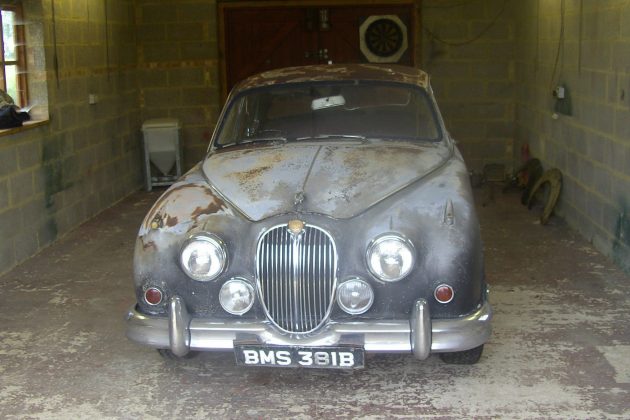
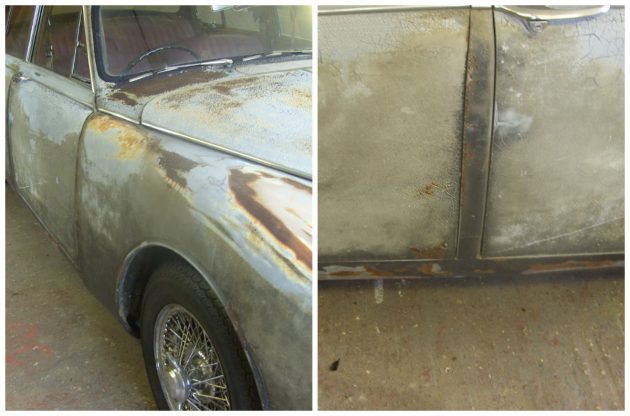
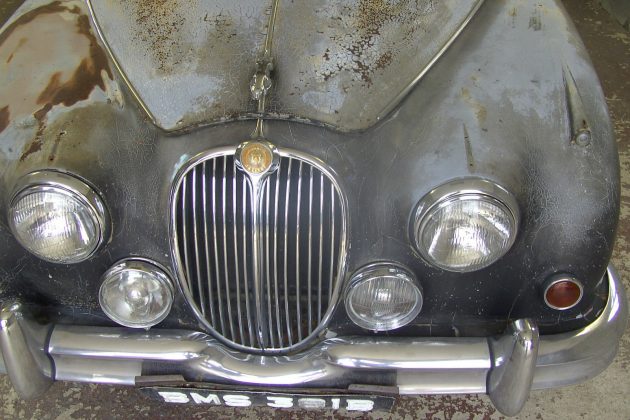
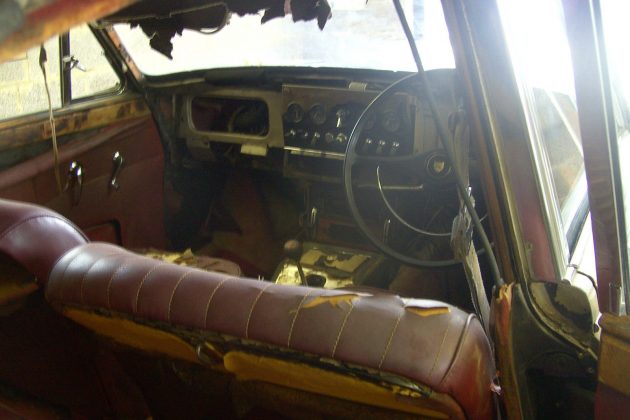
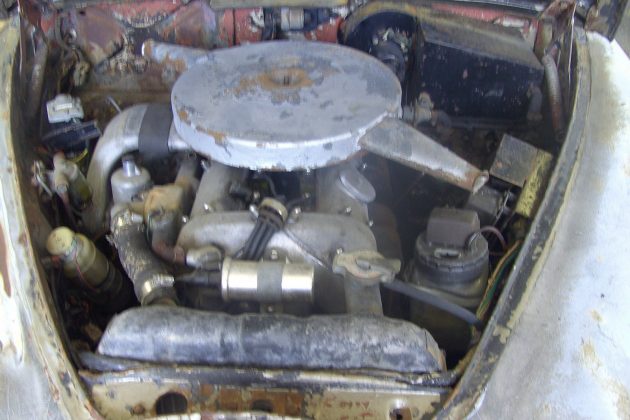



If this were on “our side” of the water, I’d be interested too! I know nothing about the 3.4 versus 3.8 issue, but this is my favorite body design of all Jaguar sedans, and should be perfectly fine with the manual-and-o/d.
I have heard that these engines can be perked up a bit without affecting reliability or original appearance, so there’s that to consider. And I would expect any Jaguar sedan of this vintage to require both woodwork and rust repair, not to mention upholstery woes. You don’t often find one that hasn’t been driven for considerable distances before being put away. If you ask me, they are much more fun to drive than Plymouth convertibles and Datsun pickups, so the odometer should reflect that.
Yes, it’s a bit pricey, but that seems to be the case when you are looking at any cars on offer in the U.K.
Toggle switches, wood, leather, and wire wheels. What a beautiful combination!
Body doesn’t look to bad, interior trim probably completely shot.
I do wish people would try to take decent photos though. Slow shutter speed = blurry images, flash helps – but can made project look worse than it is to the naked eye.
Tripod helps with low light situations.
I really love these, too. Here’s a picture of one done very nicely with a few modest upgrades (V-8, automatic, as I recall -not mine, just a picture I have collected). I bought two of these once. One was wrecked. The other rusty. I thought I could make a decent driver. Never got there! Best advice: start with a solid base.
Would have been much better to have put the car in the boat rather than dragging it behind on a rope. Did a minor restoration on one of these for a customer and there wasn’t anything easy about the rust repair. Beautiful cars when they are good….
Photography can be your friend. Sharp clear pics if you’re a buyer, soft warm pics to sell, unless the car is near 100 points.
I think the 3.4 just had smaller bores, cant remember. But the 3.8 would be a bit more torquey, but horsepower not a lot different. But more cast iron is good for longer engine life. But, these are sweet, pretty, unique cars. Worth the effort.
Al
I recall seeing photos of these as ‘saloon’ racers in car mags back when close to new. They leaned in hard tight corners, which made me think they could use thicker anti-roll bars, or maybe anti-roll bars installed in the first place. But they did haul a$$ for what was a luxury British sedan back then. That big DOHC 6 was an impressive engine in Britain at a time when the usual was a modest OHV 4, and a 3-liter OHV 6 was a big deal.
I always thought the front end on these looked really cool. My Dad liked these a lot, but the big foreign wrecking yard in the area (“Goldies”) never got a fixer in, so it never happened.
I once owned a 3.4 automatic and it was an amazing car to drive. Way back then (late 70s) the word was the 3.4 was a much nicer motor than the 3.8 but no one ever said why. Maybe it was better tuned for street driving. Still had plenty of get up and go and the car handled like a sports car. Main structural rust areas to watch were the rockers and the mounts for the rear quarter elliptical springs where they attached to the body.
Greetings All,
A quick primer on the 3.8/3.4 differences. The 3.4 is a straight port head as opposed to the 3.8 which has sort of a curved path to the piston. The 3.4 just plain breathes better and because of this it makes about the same HP with almost a half a liter of displacement less.
I own one of these that I shipped back from the UK. I’ll guarantee the bottoms of the doors will need to be rebuilt, though the door skins looked to have been replaced, so that might have been already sorted. Door skins and the bottoms suffer as Jaguar felt it necessary to glue jure/felt to the inside to quiet road noise and of course, it held water. Only car I’ve ever owned that the center of the doors rusted through, thats where the glue held the longest.
Jaguar also had a 2.4 version, we rarely see them in the US. Total production of the 2.4 exceeded that of both the 3.4 and 3.8 combined in the MKI and MKII.
Automatics worked well but competed with the SU’s for engine vacuum, one of the reasons the later Zenith carbs made the autos respond better because the ZS’s had smaller vacuum chambers, and consequently smaller vacuum demand.
It has wires, manual tranny and OD, yeap, all the good things, throw a set of triples on this and its a fun car.
Actually doesn’t look too bad.
What usually kills a UK car is their MOT. MY issue, before you UK people start flaming me………..MOT tends to make people do less long term maintenance rather than bite the bullet on the whole job based on they don’t plan on owning the car that long OR they just want it fixed “enough” to pass.
NEVER have seen people replace a partial 1/6th piece of trunk floor or a partial rocker panel. Who does that? Only in the UK will they sell you a partial repair panel, for a floor, trunk, or rocker!?!
Ross, I was pretty sure that the 3.4 in the MKII’s were “B” heads and not straight port (same as the 3.8 MKII and S-type (which came in 3.4 and 3.8 engines) with twin HD6 SU’s. The 420 had a straight port head with two HD8’s. The 3.4 head would be painted ducks egg green in the valley and the 3.8 was painted blue. I think the big difference between the 3.4 and 3.8 is the 3.4 is 3,442 cc’s with a 3.3in bore and the 3.8 is 3,781 cc’s with a 3.4in bore. Think also the 3.4 was rated at 210hp and the 3.8 was rated at 220hp. A listing of engine data can be found at:
http://xks.com/files/images/2010/12/cylinder-head-data.pdf
Had an appraisal client, a Jag collector, that had half-a-dozen of these in various stages of completeness / restoration, etc. This one is very close in quality to one he gave away. Gave away! The others were not valued very highly. Despite the availability of parts / parts cars they’re not simple to restore properly. Buy the very best you can. This car seems way over priced.
About 1971, Canadian tenants of my parents at their Old Vicarage home near Canterbury, Kent, bought a 1964 Jaguar 3.4 (manual) registration number CLE 956 B, which they took home to Canada and enjoyed thousands of miles of touring North America in this car. They still own this Jaguar which currently resides in an Ontario barn. Many years later it was realised that the well known motoring journalist Gordon Cruickshank owned a similar 1964 Jaguar (automatic) complete with the almost identical registration number of CLE 955 B. My dream is to somehow reunite these Jaguars which possibly shared a London showroom in 1964 !
Nice story, nice dream – I’m ready to help with filming!